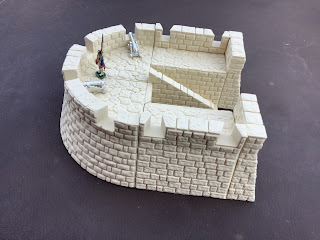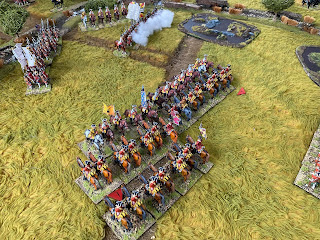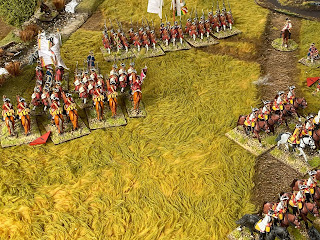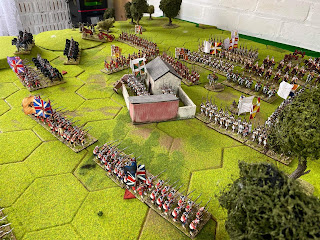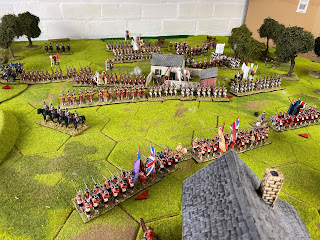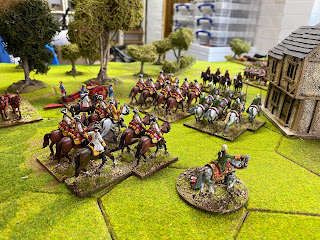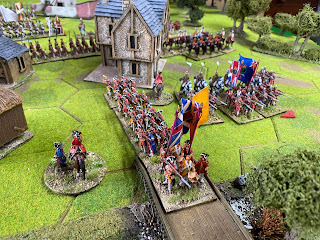During this crazy time my son and I have been trying to get a weekly game in. This week he asked if we could do 18th century - he admitted he's never looked too closely at my figure range and other than the Jacobite rebellion knew very little about the period. So as an introduction I thought I'd set up a small battle but as I'm not keen on set piece actions I reverted to one of my favourite publications and the Rearguard scenario. I've played it quite a few times and its always resulted in a good game.
So Major General David Graham with two brigades (6 battalions ) of foot, 4 squadrons of horse, a battery of 6 Pounders, some allied Jaegers and some engineers was tasked in delaying the French advance guard. To ensure the allied supply train crossed the only bridge in the area and to withdraw at least 60% of his force before successfully destroying the pont de soupirs.
As dawn broke his small force stood to his front line was deployed around the ferme de taillis and his second line around the village Brulure de Sel. Suddenly to the East the sound of drums beating carried with the wind, the early morning sun reflecting off enemy bayonets as the French arrived!
The rules used are my go to for the period -Charles Grant's the Wargame. With amendments that I'd agreed with Charles some years ago for our AMG demo game at Partizan to reflect the smaller units.
In addition movement, firing etc has been reduced by 1/3 again to accommodate the table size and the smaller units. The only addition I have made is that when I play solo I build in a little bit of friction so each bound the Brigade commanders roll a die on a 1 they can not move towards the enemy - they can retire, shoot, change formation etc. On a 6 if they so wish they can take a double move - no charges, no firing and changing formation must take place in the first move.
The French army had 9 Battalions of foot in 3 brigades , 3 batteries of artillery, a unit of Chasseurs de Fischer and 8 squadrons of horse ( one of which was Marshall Saxe's personal escort ) The French would arrive in three waves over the first three bounds.
To destroy the bridge the engineers rolled a die at the end of each bound once the total reached 24 the bridge was ready to blow. A 5 or 6 would be a successful explosion, if it failed the engineers would need another bound to refuse and then succeed on a 4,5,6 etc.
So with much panoply the French first wave advanced towards the waitng British, Regiment Foix was ordered to take the Farm, the other two regiments were ordered to advance to the South of the farm.The Cuirassiers du Roi were ordered to sweep to the North and clear the enemy cavalry
The British artillery to the North opened fire and caused early casualties to the Cuirassiers
The first two squadrons of Cuirassiers seeking glory launched a charge towards the waiting British, taking cannister and a first volley from the waiting line one squadron disappeared amidst,smoke, shot and grape - the second struck home
The Curirassiers rolled spectularly ineffective ride down dice only killing one infantry man, the result was the infantry held the cavalry in the first round of combat!!
The second round of combat saw the British infantry break, the Cuirassiers failed to pursue and fell back to rally.
The second two squadrons moved further to the North to engage the Scots Greys
The second brigade of French ( the Irish Brigade were now on the filed)
Regiment Foix occupied the Farm and Perigod were engaged with the Royal Scots and gaining the upper hand
The Allied Jaegers launched an ambush on a battery of guns causing casualties and forcing them to withdraw, The Royal La Marine deployed to neutralise the threat.
Meanwhile the fight between Cuirassiers and Greys had swung first one way and then the other, one squadron of Greys broke the other withdrew after two rounds of combat.
At this point there was a lull as the Irish Brigade hesitated and did not move forward, this allowed the British line to withdraw back toward the village. Regiment Foix moved out of the farm to commence the assault.
The third wave of French were advancing with a strong cavalry presence on their left.
Major General Graham then decided that he needed to buy more time for his infantry to withdraw and reform so he ordered the squadrons of Cavalry on his right to move forward and attack
A squadron of British Horse managed to catch Foix as they were reforming from the farm breaking them in the combat At the same time Regiment Claire took a horrendous 10 casualties from two volleys and inflicted little in return unsurprisingly the faltered only to then find themselves hit by the successful British Horse breaking upon contact.
The British had bought more time as the French sought to reorganise their lines, it was at this time the Engineers reported that the bridge was ready to blow!
The FGrench moved swiftly round the North pressing hard on the British line, to the South the French cavalry defeated the British horse and moved on to attack the infantry
Saxe even threw his lancers into the British line the Fusiliers under intense pressure eventually broke but once again they had bought time Major General Graham saw that the majority of his force was now safely over the bridge, he could do nothing for the last two regiments and he reluctantly ordered the bridge to be blown.
As you would expect a 5 was thrown and the bridge was destroyed a solid victory for the Allies but a hiogh price had been paid.
A thoroughly enjoyable game and my son is now hooked









